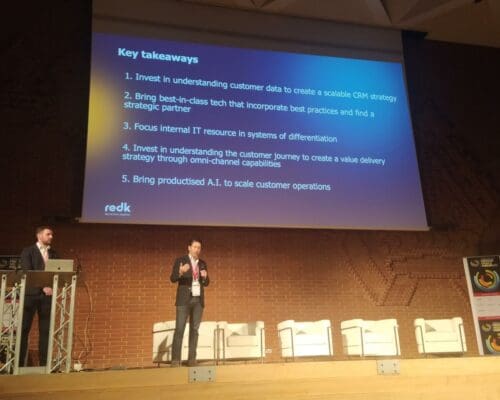Businesses in the digital era increasingly rely on data to understand their customers and tailor experiences that resonate on a personal level. Customer Data Platforms (CDPs) stand at the forefront of this evolution, providing the tools necessary to collect and manage vast amounts of data and use this information to forge exceptional customer experiences.
In this blog, we dive into how these data platforms shape customer experiences and why customer data should be integral to your business.
The Central Nerve of Customer Data
A CDP is more than a database; it is the central nervous system of customer data. It collects and combines information from various touchpoints and technologies into a centralised hub. This collection spans demographic details, transactional history, and behavioural data, ensuring every customer interaction is informed by a comprehensive understanding of their journey.
“In a nutshell, CDPs are concerned with these primary tasks: data collection, data unification, data activation, and data insights.”
Salesforce
In today’s marketplace, where customers interact with brands through multiple channels, integrating first-party data from direct interactions, second-party data from partnerships, and third-party data from external sources is crucial. This integration allows for a consistent and personalised customer experience across all platforms and points of contact.
The ability of a CDP to navigate through the labyrinth of data privacy regulations is one of its most valuable features. With rules like GDPR and CCPA changing the landscape of data usage, a CDP provides a safe harbour for companies to manage customer data responsibly while staying compliant.
The Power of Personalisation
Personalisation is not a new concept, but CDPs take it to a new level. By leveraging the unified profiles created from the aggregated data, CDPs enable businesses to deliver targeted content that speaks directly to the customer’s needs and interests.
The impact of CDPs extends beyond marketing. While they are instrumental in driving personalised campaigns that have been shown to increase revenue and marketing efficiency significantly, their influence permeates the entire organisation. Sales teams, customer service, and business units benefit from having access to a unified customer view, allowing for a cohesive strategy that ensures every interaction is personalised and informed.
With CDPs, marketers can create and execute campaigns that reach and resonate with their audience, driving engagement and loyalty. The data-driven insights provided by CDPs mean that every decision is backed by a deep understanding of customer behaviour, leading to more effective personalisation at every touchpoint.
The ripple effect of using a CDP is seen in reduced customer acquisition costs and improved retention rates.
By focusing on building lasting relationships through personalised experiences, businesses can shift their strategy from constantly acquiring new customers to maintaining and deepening existing relationships, thus maximising the lifetime value of each customer.
The Operational Backbone of Customer Data
Operationalising customer data through a CDP involves a series of complex processes that work seamlessly behind the scenes. Data from various sources is ingested, identities are resolved, and profiles are continuously updated and enriched to reflect the most current customer information.
The integration capabilities of CDPs bridge the gap between various technology platforms and the customer data they generate. Through APIs and connectors, CDPs are the glue that holds the technology stack together, providing a single point of truth that can be leveraged across all systems and tools.
Advanced CDPs are infused with machine learning and artificial intelligence, allowing for predictive analytics and dynamic segmentation. These features enable marketers to anticipate customer needs and craft messages that are timely and highly relevant to the customer’s current position in the buying journey.
Redefining Customer Relationships
CDPs are redefining how businesses approach customer relationships. By offering a nuanced understanding of each customer, they enable a shift from broad, generic marketing to highly focused and individualised experiences. This level of personalisation is not just what customers prefer; it has become what they expect.
With a CDP, customer engagement is not a one-off event but a continuum. Each customer interaction is an opportunity to learn and refine the customer profile, informing the next interaction.
This virtuous cycle creates a dynamic where the customer experience constantly evolves and improves, fostering a deeper sense of loyalty and satisfaction. The predictive capabilities of CDPs allow businesses to stay a step ahead. By understanding patterns and predicting future behaviours, companies can proactively provide solutions and services that meet customer needs even before they arise. This anticipatory approach to customer service and marketing sets the stage for remarkable experiences that can differentiate a brand in a crowded market.
Streamlining Operations with a Unified View
The operational benefits of a CDP cannot be overstated. By streamlining customer data into a single view, businesses can break down silos that traditionally separate departments and initiatives. This unified view fosters collaboration and efficiency, making every aspect of the organisation more responsive to customer needs.
The strategic value of a unified customer profile lies in its capacity to inform decision-making at all levels of the organisation. From front-line customer service representatives to top-level executives, the insights provided by a CDP guide a company to operate with a customer-centric approach.
CPDs Empower Businesses
The customer experience is the new battleground for businesses, and CDPs are the sophisticated weaponry needed to compete. They empower organisations to understand their customers like never before, delivering personalised experiences that can turn satisfaction into delight. As we move forward in the digital age, the companies that will lead are those that recognise the transformative power of a CDP not only to shape but also to elevate the customer experience to new heights.










